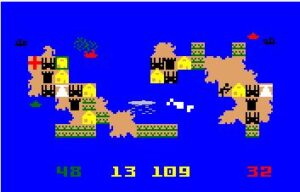It’s Your Turn: Understanding Game-Based Learning
Rhea checks the cargo hold of her sailing ship. Everything has been loaded exactly as she directed. Grain from nearby farms bulge from linen sacks. Coal, iron ore, and stone are loaded into neatly stacked crates. These goods will fetch a high price at the market town two islands to the west. Rhea is eager to cast off for distant lands and greater profits.
Who is this person? Is she a merchant from the Middle Ages? Or is she a famous pirate or captain? Rhea can be any of those things, at any time she wants. In many ways she can become almost anything imaginable. Rhea is an avid player of simulation and strategy video games. These games offer a chance for some educational fun.
The Simulation and Strategy Genre
Simulation and strategy are popular genres in video gaming today. Both genres challenge players to solve problems with skillful thinking and planning. Simulation games enable the player to re-enact various historical or modern-day activities. Strategy games are similar, but emphasize problems on a larger time frame. Believe it or not, Social Studies concepts and content often take center stage in these games.

The Utopia game was one of the first simulation games created for the personal computer in the 1980s.
Released in 1982 on the Intellivision video game console, Utopia allowed players to control the military and economy of a small island. Utopia wasn’t like most video games from this era. Most games at this time were about hand-eye coordination. But Utopia emphasized deep thought and planning. This style of play directly influenced simulation and strategy games that followed it, which have come a long way since then! Advances in technology have improved graphics and enabled developers to create games with rich detail.
Simulating Life from Top to Bottom
It’s Monday morning and Brad, mayor of Bradopolis, faces a crisis. Bradopolis suffers from high unemployment, but Brad has a solution. He sections off a large area just north of town as a heavy-industrial zone and factories start moving in. The factories bring jobs and the unemployment problem is solved!
But Brad’s solution seems to create even bigger problems for Bradopolis. Heavy industry means more pollution. The citizens of Bradopolis are complaining about all the smog. Traffic is an issue now too. When Brad planned his new industrial zone, he forgot to add new bus stops, subway stops, or highway exits. The newly employed citizens of Bradopolis are all crowding the same small side streets to get to work. Traffic has ground to a halt and the air is thick with pollution. Mayor Brad will get right to work on these problems—after he completes work on the city’s new sports stadium, named after him, of course.
Brad isn’t really a mayor—he’s playing a simulation game called Sim City. First published in 1989, Sim City is a direct descendent of Utopia. The goal of Sim City is to design and build a city from the ground up. As “mayor,” the player makes many decisions faced by modern cities. The player zones land as commercial, industrial, or residential, adds government buildings, changes the tax rate, builds a power grid and transportation system, and undertakes other actions to improve the city. Sound boring? When building and customizing your own city with Sim City’s graphics, these ordinary activities become fun and entertaining.
6,000 Years in One Afternoon
Jackie, Queen of Egypt, looks over her empire with satisfaction. Egypt is at peace and its population continues to grow. But storm clouds are gathering on the horizon. For centuries the Carthaginian people across the sea have traded their horses for Egyptian stone. Recently, Hannibal, the leader of Carthage, broke this agreement. Queen Jackie, nervous about Hannibal’s motives, readies her army and her navy to defend Egypt should Carthage attack. In the meantime, she looks to the nearby nations of Arabia and Mali for a new source of horses.
Of course, Egypt never had a queen named “Jackie.” But it can in the strategy game Civilization. Unlike simulation games, strategy games often focus on broad sweeps of history. Civilization is a great example of this. First published in 1991, the Civilization player takes on the role of the ruler of a civilization and attempts to build an empire in competition with other civilizations. Along with the challenges of exploration, settlement, land improvement, war, and diplomacy, the player has to make decisions about which enhancements or units to build in each city and which technological advances to pursue.
Simulation and Strategy in the Classroom
Even though the Sim City and Civilization series were created for entertainment, many educators have found effective ways to use these games in the classroom. One of the Sim City Teacher’s Guide publications provides a long list of ideas for using Sim City in individual, group, and whole-class projects. Many of these activities provide a direct example of how cities develop and operate—and what can happen when things don’t quite work as intended. Ask your teacher if your class could use one of these games!
The Future
As with all of video gaming, simulation and strategic gaming continues to develop and grow. Advancements in computer technology mean that these games will become even more immersive and detailed. And the more detailed these games become, the more use they’ll have in the classroom. So while you wait on these advancements, know that there are great simulation and strategic games out there to entertain and test your brain.
Related Links:
- Read more about the history of video gaming at The Video Game Revolution: History of Gaming.
- You can play the original version of Sim City at this Web site.
- Visit the homepages for the Sim City series and the Civilization series.
